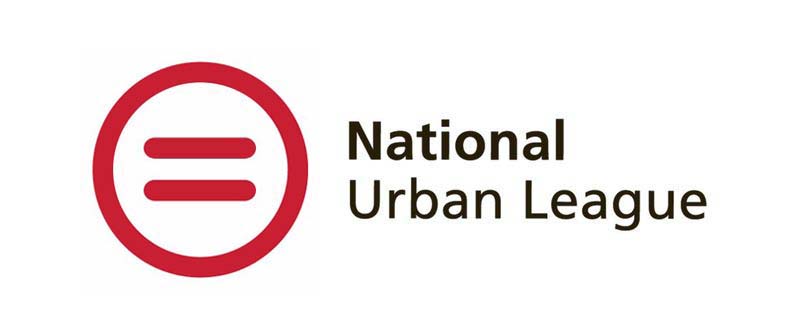Artificial intelligence (AI) and machine learning are all the rage right now. And as an early-career software engineer, you might think that using something like ChatGPT to write your software engineer cover letter is the perfect way to save time and showcase your knowledge of this cutting-edge field.
For the most part, you’d be right. Using AI to write your cover letter is a great way to demonstrate you understand how to prompt and train a bot. And if you get the prompts right, you can save yourself some time. But how and where should you start?
Using ChatGPT to Write a Software Engineer Cover Letter
Using ChatGPT to write any cover letter starts with your prompt. Tell the bot what you want, and it produces an output. It sounds simple enough, but there’s more to using ChatGPT for a software engineer cover letter than one simple step.
Here’s how to get the most out of the process.
Step 1: Ask ChatGPT to Generate a Software Engineer Cover Letter
Start by asking ChatGPT to write an entry-level (or whatever level you’d like) software engineer cover letter. But as part of that prompt, ask ChatGPT to pretend it’s a college senior who’s graduating soon and looking for their first job.

Software Engineering
Learn how to crack a leaked password database in this free virtual job simulation from Goldman Sachs.
Avg. Time: 2 hours
Skills you’ll build: Cryptography basics, password cracking, password best practices
I know. This seems like a bit much. However, a basic prompt like “Write an entry-level software engineer cover letter” isn’t enough.
ChatGPT will do what it’s trained to and create a decent rough draft of an entry-level software engineer cover letter. But asking it to approach the chat from a specific perspective will help the bot generate an output that’s more specific to your situation. While ChatGPT doesn’t know what it’s like to be a graduating college senior who’s looking for their first software engineering job, including some context in the prompt helps ChatGPT draw from a more specific data set (what it was trained on) and that usually results in a better output.
So, I asked ChatGPT to act as if it’s a graduating college senior and write a cover letter for an entry-level software engineer role from that viewpoint. Here’s what I got:
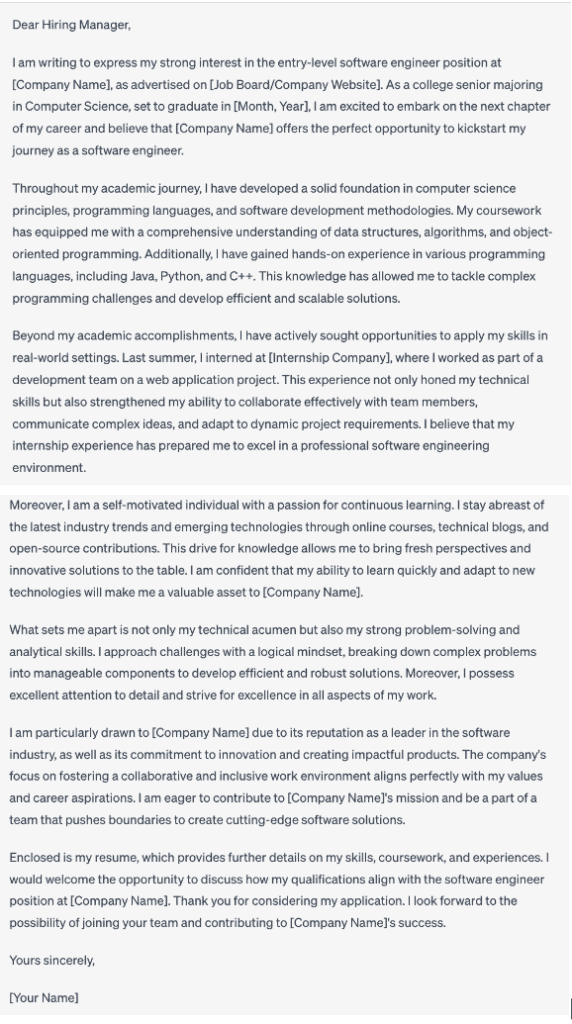
Overall, this isn’t a bad place to start a software engineer cover letter. It talks about academic achievements as well as software engineer activities outside of the classroom. Including academic and nonacademic information demonstrates you’re passionate about software engineering and dedicated to continual learning and growth (instead of just saying you are).
It also does a nice job of explaining why I want to work for this particular company. The cover letter talks about the company’s culture and names a few specifics, like the company’s reputation and the kind of workplace it is.
And while signing a letter “Yours sincerely,” isn’t quite right (it’s “Yours Truly” or “Sincerely”), the line “kickstart my journey as a software engineer” is magnificent!
>>MORE: How to End an Email Professionally (With Examples)
Step 2: Make Your Software Engineer Cover Letter Specific
While this is an excellent example cover letter, it’s just that — an example. It’s very broad and doesn’t say much outside of what it claims my skills are. There are no examples of how I used my skills and what the results were.
To make this software engineer cover letter shine, you could use this output as a guide, then rewrite it, tailoring your new version to explain how you used your skills, what the results were, and tie them to the specific job you’re applying for. Or, you could have ChatGPT do the heavy lifting for you.
I asked ChatGPT to tailor the cover letter to a job description. The specific prompt was:
Not bad. Now please tailor the cover letter to this job description:
This prompt is different from those we’ve previously tested. Instead of saying “rewrite,” I asked ChatGPT to “tailor” the cover letter. Why? In the past, using “rewrite” has resulted in a vastly different cover letter. It was tailored to the job description but sometimes dropped things I wanted it to keep. Using the word “tailor” tells the bot to tweak the output, keeping most of it intact.
I also complimented what ChatGPT produced. While I know it doesn’t have feelings (right?), each “conversation” I have is a training session. Telling ChatGPT what it got right or wrong helps it “learn” and usually results in a better output more quickly.
Here’s what I got:
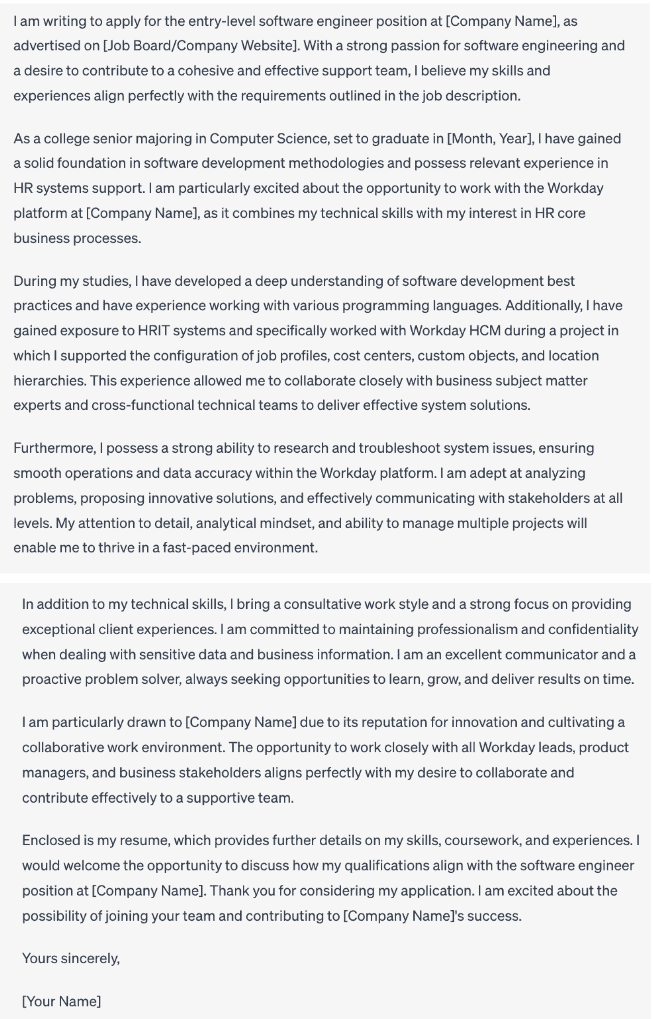
This is also a decent cover letter. It’s shorter than the first software engineer cover letter, but that’s OK. ChatGPT maintained the general tone and outline of the first output. However, one of the problems with this cover letter is that it parroted back parts of the job description you wouldn’t want to include.
For example, ChatGPT wrote, “I am committed to maintaining professionalism and confidentiality when dealing with sensitive data and business information.”
The job posting has a bullet point that says, “high level of professionalism and confidentiality in dealing with confidential data and business information,” but it’s likely included for legal reasons.
While a high level of professionalism and confidentiality is vital in almost every job, it’s generally assumed you’ll behave this way and don’t need to mention it in your application. It’s far better to delete that sentence and talk about your skills and how you’ll use them on the job.
>>MORE: What Are Job Skills? Definition and Examples

Forage Find
Ideally, you’d include your resume in the prompt and ask ChatGPT to write a cover letter using that information. But if you don’t want to, that’s OK! Do whatever you’re comfortable with!
Step 3: Get Into the Details
At this point, you could stop using ChatGPT to generate your software engineer cover letter and use the output as a rough draft. You’d then tailor it with details specific to your experience and abilities.
Or, you could ask ChatGPT for a little help!
I asked ChatGPT to dig into the details and create more specific examples of how I use my skills. Here’s what I asked:
Rewrite the sentence I’m going to input, but include examples of what I did on the project. Include specific examples of how I supported the configurations of job profiles and location hierarchies. Make this rewrite no more than 3 sentences.
Here is the sentence: Additionally, I have gained exposure to HRIT systems and specifically worked with Workday HCM during a project in which I supported the configuration of job profiles, cost centers, custom objects, and location hierarchies.
This time, I did ask ChatGPT to rewrite the sentence instead of tailoring it. I felt the original output was vague, and wanted something more detailed and specific. This would have been a smoother process if I had included my resume, but since I didn’t (and I’m not a software engineer), I had to adjust how I prompted ChatGPT.
And because I know ChatGPT is a bit wordy on rewrites, I gave it a limit of three sentences, forcing it to be concise with the output:

The output is just OK. I asked for a specific example of the hierarchy I created, and this is still vague. But it does explain what the outcome of my new setup was (streamlined reporting and organization).
>>MORE: How to Use the STAR Method for Interview Questions
Step 4: Tell ChatGPT to Try Again (and Again)
While the above output isn’t bad, it’s not great and not quite what I was looking for. And this isn’t unusual. You’re training the bot, so you may have to repeat your question a few times while it learns.
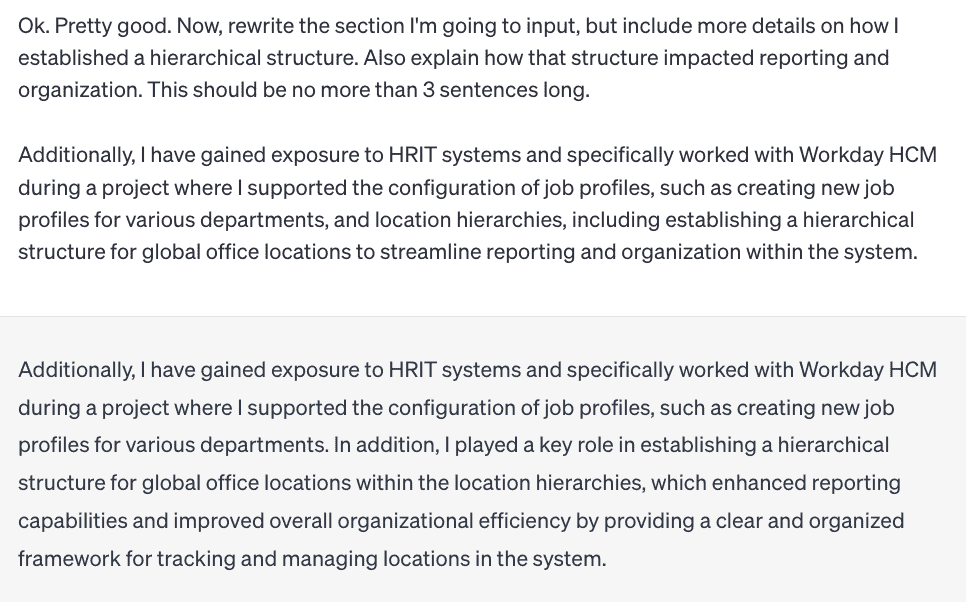
This is not what I had in mind. I don’t know much about software engineering, but I feel like ChatGPT is talking in circles.

Forage Find
The recruiter reading your application may not understand all the ins and outs of the role or how your skills are a match. It’s up to you to connect the dots for the reader.
With that in mind, I asked the bot to try again and made sure it understood it was on the wrong path:
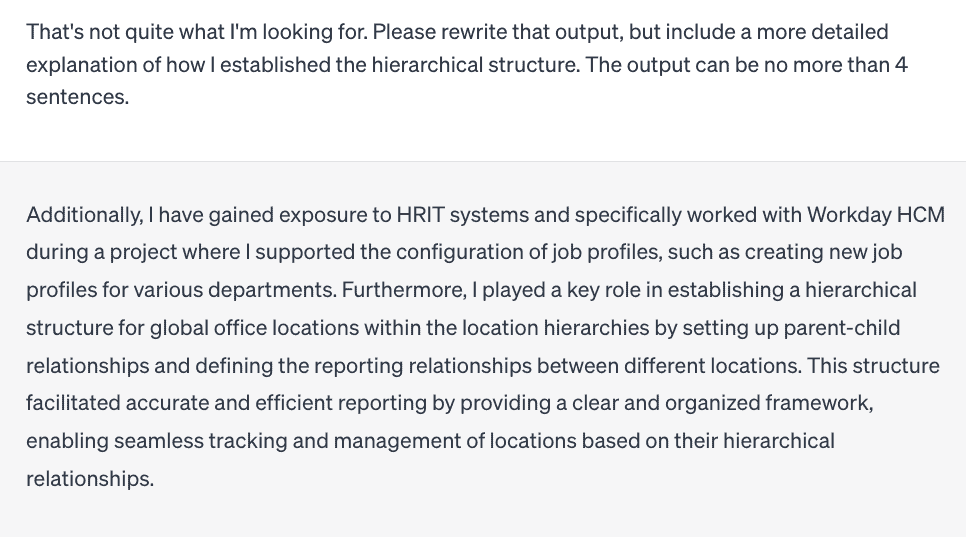
Much better! This is a more detailed and precise explanation of how I set up the hierarchy. Someone who doesn’t know how hierarchies work should be able to understand this explanation.
Step 5: Keep Things Going
Now that ChatGPT “gets” me, I can have it rewrite other parts of my software engineer cover letter. This time, I asked it to get specific about some of my soft skills:
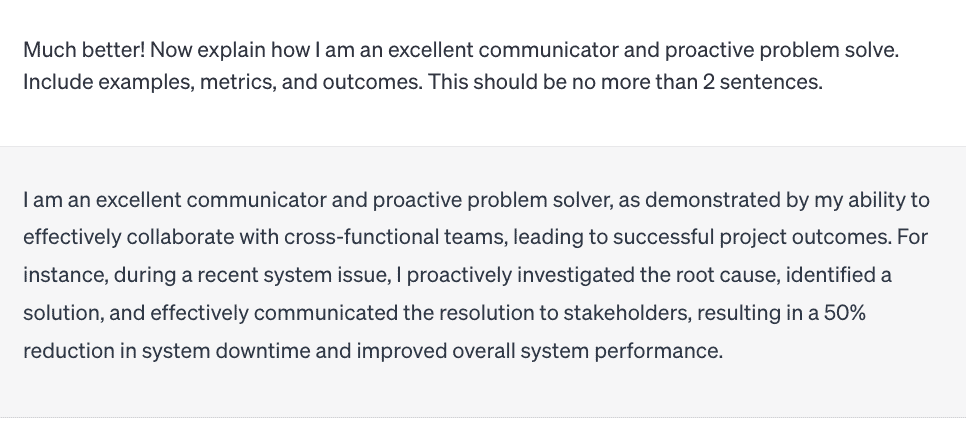
First, thank you, ChatGPT, for fixing my typo!
But beyond the spellcheck, this explanation of how I used my soft skills not only explains what I did but what the outcome was using a specific metric.
Now I can go through each line of the cover letter and ask ChatGPT to make similar changes and feel fairly comfortable that the bot will get it right.
Step 6: Make the Cover Letter Yours
Of course, this is just a guide. I should not submit this cover letter as mine. I didn’t actually do any of the things ChatGPT says I did!
This is partially my fault. I didn’t include my resume in any of the prompts. In other tests when I’ve included a resume, the cover letter is far more specific to me. So the final step is to personalize this cover letter.
Go back through all of ChatGPT’s outputs, pull out the best parts, then personalize it from there.
For example, the first cover letter included the excellent line about kickstarting my career. That wasn’t in the second version, so I’d definitely want that in my final version. Plus, the first version talked about some of the things I did outside of school. So, depending on your situation, you may want to include that kind of information, too.
Ultimately, you’ll want to take the best parts of each output and personalize it with your information. Below is a downloadable example of what that could look like:
Learn other ways ChatGPT can help you in your job search:
- How to Use ChatGPT in Your Job Search
- Should You Use ChatGPT for Interview Advice?
- Can You Use ChatGPT to Prepare for Technical Interviews?
- We Asked ChatGPT to Write Cover Letters. Here’s What It Got Right and Wrong
- I Asked ChatGPT to Write Resumes, Including Mine. Here’s What Happened.
Image credit: Canva

